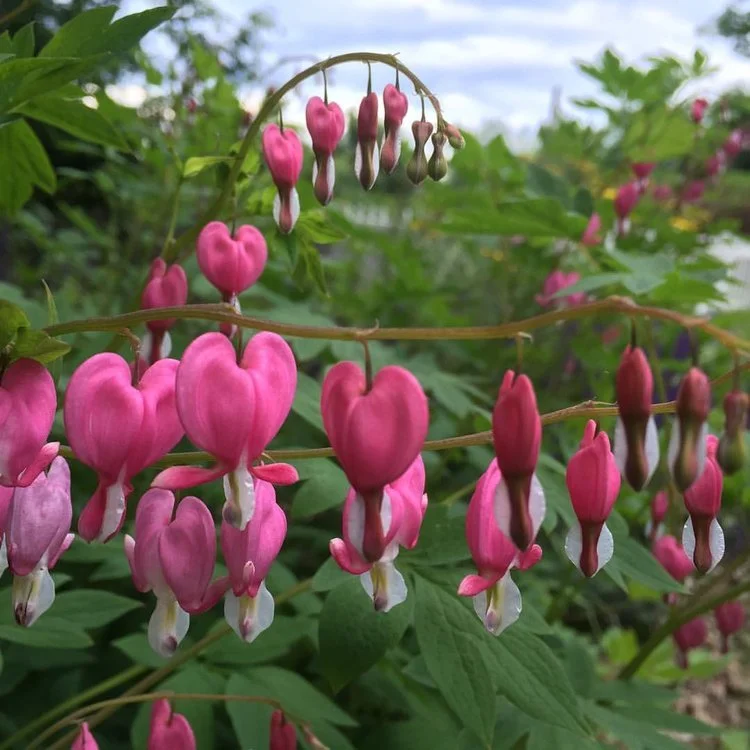Bleeding Heart
(Lamprocapnos spectabilis)
Photo By Ilana Sobo. In The Garden (Sherman, CT)
Bleeding Heart
Bleeding heart (Lamprocapnos spectabilis), with its enchanting, heart-shaped flowers that dangle like charms on a necklace, is a beloved perennial in shaded gardens. Native to Asia and North America, it symbolizes compassion and deep emotion in folklore and has long inspired poets and gardeners alike. Its delicate blooms and feathery foliage make it a striking yet safe choice for gardens when grown with care and caution. They are particularly attractive to long-tongued bees, such as bumblebees, which can reach the nectar. Additionally, hummingbirds are drawn to bleeding hearts, making them a lovely addition to pollinator-friendly gardens.
Bleeding hearts are stunning shade-loving perennials that thrive alongside other plants with similar growing preferences. Here are some excellent companions to consider for creating a harmonious and enchanting garden.
Ferns make wonderful companions, with their soft, feathery fronds providing a beautiful texture contrast to the arching stems of bleeding hearts. Similarly, hostas are an excellent choice, offering lush, broad foliage in shades of green or variegated patterns that perfectly complement the delicate blooms.
Astilbes, with their feathery plumes of flowers, pair beautifully with bleeding hearts, adding height and vibrant color to the garden. Heucheras, also known as coral bells, bring a pop of color with their stunning foliage in shades of purple, bronze, and green, creating a striking visual contrast. Lungwort, or Pulmonaria, offers speckled foliage and brightly colored flowers in pink, blue, or purple, harmonizing well with the early spring bloom time of bleeding hearts.
For groundcover, the herbal medicinal sweet woodruff is a delightful option. This low-growing plant produces tiny aromatic white flowers and has a delicate appearance that complements bleeding hearts perfectly. Epimedium, with its heart-shaped leaves and dainty blooms, and lamium, with variegated foliage and soft pink or white flowers, are also excellent choices for filling in space around the garden.
Spring bloomers like Virginia bluebells add pastel blues that pair beautifully with the pinks or whites of bleeding hearts. Trilliums, native wildflowers with their elegant blooms, and primroses, with their vibrant colors, further enhance the charm of a shade garden.
To ensure continued interest in the garden after bleeding hearts have finished blooming, later-season plants like Japanese anemones can bring fresh bursts of color. Their blooms in late summer are a perfect complement to the earlier floral display. Solomon’s seal, with its graceful arching stems and delicate white bell-shaped flowers, also offer additional beauty and blends seamlessly with bleeding hearts' form.
When planning a garden, it’s essential to consider the growing conditions of your plants. Bleeding hearts thrive in part to full shade and prefer moist, well-draining soil, so be sure to select companions that share these preferences. Additionally, because bleeding hearts may go dormant in mid to late summer, pairing them with plants like ferns, hostas, or other shade lovers will help fill in any gaps and maintain a lush, vibrant garden throughout the season.
By choosing the right companions, you can create a dreamy woodland garden filled with layers of texture, color, and seasonal interest.
*Please Note
While breathtakingly beautiful, all parts of the bleeding heart plant are toxic if ingested, containing alkaloids that can cause nausea, vomiting, and breathing difficulties. Handling the plant may also irritate sensitive skin, so wearing gloves when pruning or planting is advised. Bleeding heart is purely ornamental and not used in herbal medicine except as a flower essence which does not contain isoquinoline alkaloids.

